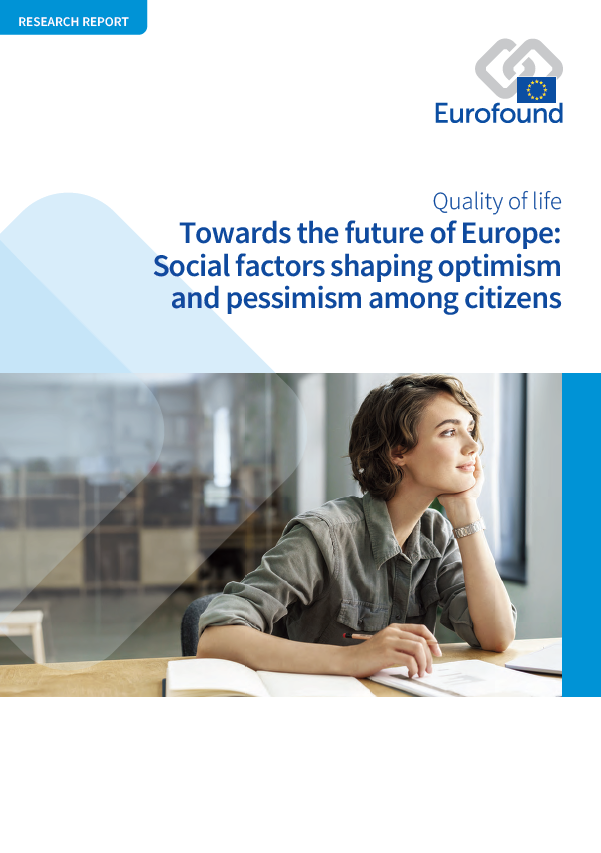I mere end et årti har der været stigende usikkerhed om fremtiden i de fleste dele af EU. Mange mener, at samfundet er i tilbagegang, og det har givet anledning til generel pessimisme. Er der en sammenhæng mellem antiautoritære partiers stigende popularitet og den stigende pessimisme? Sådanne negative opfattelser kan have en negativ indvirkning på det politiske klima i de enkelte medlemsstater og underminere det europæiske projekts legitimitet. Denne rapport identificerer de vigtigste drivkræfter for, hvordan folk opfatter fremtiden, og undersøger, om optimister og pessimister er forskellige med hensyn til socioøkonomiske, kulturelle og politiske karakteristika. For at undersøge, i hvor høj grad der er forskel på, hvordan optimister og pessimister optræder og føler, ser rapporten på deres socioøkonomiske og sociopolitiske profil. Endelig undersøger den, hvordan graden af optimisme er forskellig i medlemsstaterne som helhed og i de enkelte lande. Analyserne bygger på data fra før covid-19-pandemien, men viser, hvor vigtigt det er at overvåge, hvordan folk opfatter fremtiden under genopretningen efter krisen.
Key findings
As Europe emerges from the pandemic, it will be crucial for policymakers to understand the drivers of optimism and pessimism in order to address the challenges arising from potentially growing disillusionment. Evidence shows that high levels of pessimism can undermine social cohesion and the legitimacy of the established political system.
Age appears to have the greatest net effect on social optimism: young people were found to have the happiest outlook, in middle age there was a dip in positivity, then optimism increased again among older people.
Trust in institutions and GDP growth rates were found to be key country-level drivers of optimism. Evidence highlights that facilitating access to high-quality public services can help to (re)build trust in institutions.
Citizens who feel their voice counts are not only more optimistic about their own future but also about the society in which they live. Initiatives that involve citizens in the debate about the recovery process, such as the Conference on the Future of Europe, will be critical going forward.
Findings point to the important role a person’s place in the labour market and their financial situation plays in their perception about the future. As emphasised by EU leaders in the 2021 Porto Declaration, a shift in policy focus from protecting jobs to creating new opportunities will be required to improve the EU’s employment situation.
The report contains the following lists of tables and figures.
List of tables
- Table 1: Social Optimism Index – Six questions
- Table 2: Assessment of the impact of the economic crisis on the job market by social optimism level, EU27, 2019 (%)
- Table 3: Key drivers of social optimism and pessimism
- Table 4: Perceptions relating to the economic crisis by level of social optimism, EU27 (%)
- Table 5: Views on the future living conditions of children and young people by level of social optimism, EU27 (%)
- Table 6: Political efficacy by level of social optimism, EU27 (%)
- Table 7: Voting behaviour by level of social optimism, EU27 (%)
- Table 8: Assessment of the political system by level of social optimism, EU27 (%)
- Table 9: Perceptions of the EU by level of social optimism, EU27 (%)
- Table 10: Prospects for future generations in the EU by self-reported social class, EU27 (%)
- Table 11: Subjective social mobility and optimism, EU27 (%)
- Table 12: Perceptions of social inequality by level of social optimism, EU27 (%)
- Table 13: Views on potential political actions to tackle inequality by level of social optimism, EU27 (%)
- Table 14: Personal and societal sense of fairness, EU27 (%)
- Table 15: Personal and societal sense of fairness by level of social optimism, EU27 (%)
- Table 16: Social optimism: country-level domains and factors
- Table 17: Personal and societal expectations: level of optimism in the EU27 (%)
List of figures
- Figure 1: Social optimism: emotional dimension, EU27, 2019 (%)
- Figure 2: Social optimism: evaluative dimension, EU27, 2019 (%)
- Figure 3: Social optimism: cognitive dimension, EU27, 2019 (%)
- Figure 4: Social Optimism Index scores by response category
- Figure 5: Expectations about a return to growth following the economic crisis by level of social optimism, EU27, 2017 (%)
- Figure 6: Perceptions about change in quality of life by level of social optimism, EU27 (%)
- Figure 7: Opinion about prospects for future generations by EU Member State (%)
- Figure 8: Likelihood of voting in the next European Parliament election by level of social optimism, EU27 (%)
- Figure 9: Image of the EU by level of social optimism, EU27 (%)
- Figure 10: European identity by level of social optimism, EU27 (%)
- Figure 11: Social optimism by self-reported social status, EU27 (%)
- Figure 12: Views about state intervention by level of social optimism, EU27 (%)
- Figure 13: Belief in functioning meritocracy by level of social optimism, EU27 (%)
- Figure 14: Social Optimism Index scores (mean) by EU Member State
- Figure 15: Proportion of optimists and pessimists by EU Member State (%)
- Figure 16: Pessimism gap: personal and societal pessimism by EU Member State (%)
- Number of pages
-
70
- Reference nº
-
EF21004
- ISBN
-
978-92-897-2203-2
- Catalogue nº
-
TJ-03-21-369-EN-N
- DOI
-
10.2806/458259
- Permalink
Cite this publication
Eurofound (2021), Towards the future of Europe: Social factors shaping optimism and pessimism among citizens, Publications Office of the European Union, Luxembourg.
